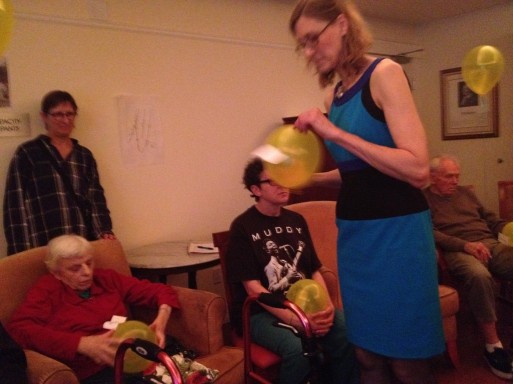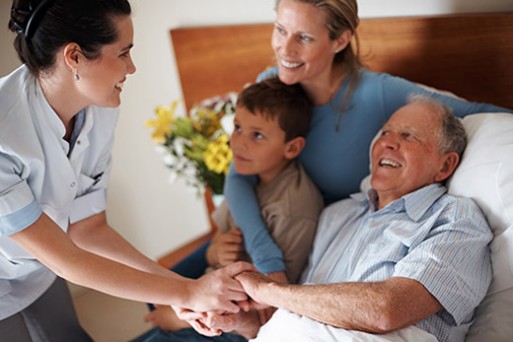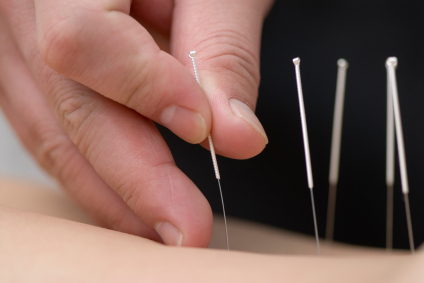Today SevenPonds speaks with Sheena Boyd, a former UK hospice worker at St. John’s Hospice in central London. Boyd has had 10 years of hospice experience as a day services manager, where she would help clients maintain a quality of life in the face of a terminal diagnosis. Most recently, she was volunteering with AgeSong Senior Community Services in San Francisco.
Kimberly: One of the main tenants of hospice is to help people maintain dignity towards the end of their lives. What steps did you take to help make this possible for your patients?
Sheena: Our approach wasn’t set up to preserve a sense of dignity—we were offering clients the opportunity to have a quality of life that meant something to them. We were essentially a service that offered people an opportunity to come from home and visit with us one or two days a week. For some people, that might be very limited. It might be as simple as having a meal twice a week with other people. For other people, it might mean that they embarked on a few months of learning a skill and looking at what they are capable of doing. What I did with my colleagues was to set up a series of programs and services that would tap into what meant something to our clients.
Kimberly: Some of the services at St. John’s Hospice, where you used to work, included therapy and exercise classes, which is not something that is typically associated with how many people view hospice care. Can you give us a better idea of what a ‘typical’ hospice patient is like?
Sheena: As an aside, when I first started working at St. John’s and I talked with people about how they would like to be considered, they came up with the word ‘clients.’ They didn’t like the word ‘user’ because of the association with drugs and they hated the word ‘customer’ or being known as ‘patients.’ They weren’t ready to be patients and it was an important step for us to refer to them as ‘clients’ as well. Psychologically, the connotation with ‘patient’ was that that was nearer to the end of their life and they weren’t ready to acknowledge that, which for them, was healthy.
As to your original question, our perception was that when people are going through a massive, life-changing event, it paralyzes people and they very quickly become consumed with the idea of an illness. No one came to us with the same illness trajectory. People were coming to us with very different stories. And since St. John’s was located in central London, we had one of the most diverse communities because of the nature of it being in London.
We had a very diverse age group of people coming to us with ages from the early twenties to the late eighties and everywhere in between. We would never assume, based on a client’s medical record, what their emotional or physical state was. It was only until we actually were able to meet with them, and very often, the mention of hospice does not engender a sense of comfort, so it was important for us to immediately make the hospice seem like a comforting environment.

Sheena Boyd standing at back left with SevenPonds founder Suzette Sherman holding balloon in foreground at AgeSong.
(credit: AgeSong San Francisco Blog)
First, we needed to understand their conception of hospice and secondly we needed to understand their back story. In all cases, whether they had great family support or not, the major theme was isolation. It might be isolation within a family unit, or within perception of support. When you are going through an illness, there is always a point where you feel closed off from everyone else who is not going through this experience.
We never expected people to take up our services in the same way. Everyone knew where things were happening and when they were happening. Anyone could join us whenever they felt comfortable to include themselves in a session.
Kimberly: Do you have any memorable experiences that you can share with us in regards to your work as a hospice worker?
Sheena: People would often come to me in their own way and say, “When I was diagnosed and I knew that I had a certain amount of time, I had lost all of my friends anyway, and in this end stage of my life, I never thought that I would make friends. It doesn’t matter that I would be one of the friends that they lose, or that I am going to lose them at some point, it’s more important to make friends again.” They would say this in the context of being able to sit down at a table once or twice a week to eat a meal with others, which is something that they never thought they would do again.
Kimberly: Are there alternative means for dealing with pain besides pain medication?
Sheena: Absolutely. It’s recognizing that I was under the responsibility of the medical model in regards to care, but also recognizing that the person will come with their own bit of understanding, beliefs and stories with regards to how they will view their illness. It might be as simple as that they would rather understand the pain, or it might be because of a cultural or religious background. But certainly, we find that being able to offer an alternative, which is therapy, and in a lot of cases, particularly acupuncture, was necessary to deal with the pain.
I’m not a scientist or a researcher, but it worked, and a lot of people who came to us on huge amounts of pain medication, and did not like the side effects of not knowing themselves when they were on pain medication, would gradually wean off pain medication as they would increase their sessions with the acupuncturist until they could cut down on the medication in the end, and still have lower pain doses.
Kimberly: Lastly, please give us a word of advice for how clients, families and friends can cope with the terminal diagnosis.
Sheena: Pick the analogy that suits you in relation to how you want to deal with your illness. A lot of people will immediately jump to the idea that you are going into battle. Even the media will do that. We are guilty of doing this in hospice as well. ‘Go into battle,’ ‘rally the troops,’ ‘the fight is on,’ ‘we are gonna win this,’—all of those war analogies are something that we have latched on to. But this type of war rhetoric is not for everyone and I would say that people should be very careful of using this.
Family and friends can help a client find their own ideology in this. It may be that they would prefer to think of an angel on their shoulder, or they might want to think of embracing more. To jump to war rhetoric is a big mistake and it allies the idea that somehow we are at war with our own body.
For hospice workers themselves, they should not assume anything and they should really pay attention to the client and their story.
Kimberly: Thank you for taking the time to speak with us!
Sheena: Thank you!
Related SevenPonds Articles:
- 10 Facts About Hospice Care You May Not Know
- What Are Hospice Services? An Interview with Amy Tucci
- What is an End of Life Doula? An Interview with Amy Levine

 How Does Hospice Improve Quality of Life? An Interview with Sheena Boyd
How Does Hospice Improve Quality of Life? An Interview with Sheena Boyd





 “In Case You Don’t Live Forever” by Ben Platt
“In Case You Don’t Live Forever” by Ben Platt
 Our Monthly Tip: Make an “In Case of Death” File to Ease Loved One’s Grief
Our Monthly Tip: Make an “In Case of Death” File to Ease Loved One’s Grief
 Passing of Beloved Comedian Births a New Comedy Festival
Passing of Beloved Comedian Births a New Comedy Festival














